|
|
|
Sort Order |
|
|
|
Items / Page
|
|
|
|
|
|
|
| Srl | Item |
| 1 |
ID:
083516
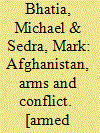

|
|
|
|
|
| Publication |
London, Routledge, 2008.
|
| Description |
xxvii, 324p.: figures, maps, tableshbk
|
| Series |
Contemporary Security Studies
|
| Standard Number |
9780415453080
|
|
|
|
|
|
|
|
|
|
|
|
Copies: C:1/I:0,R:0,Q:0
Circulation
| Accession# | Call# | Current Location | Status | Policy | Location |
| 053935 | 958.1047/BHA 053935 | Main | On Shelf | General | |
|
|
|
|
| 2 |
ID:
107877
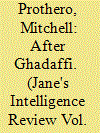

|
|
|
| 3 |
ID:
072216
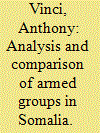

|
|
|
| 4 |
ID:
097066
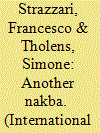

|
|
|
|
|
| Publication |
2010.
|
| Summary/Abstract |
Violent clashes of June 2007 saw Hamas ousting Fatah from the Gaza Strip, thereby making patent the existence of a deep politico-military split within the Palestinian national movement. This article sheds light on the present face of the conflict in the Palestinian territories by adopting a historical-analytical perspective that emphasizes the role played by the availability of small arms and light weapons, as one of the many structural factors that underlie the transformation of the Palestinian struggle. Aware of the essentially contestable and reductionist nature of this endeavor, the authors examine the way in which the weapons acquisition process has changed in the time period from the beginning of the first Intifada in 1987 to the Gaza take-over by Hamas, 20 years later. In doing this, they extend the applicability of existing theories about the correspondence between access to weapons and the changing nature of insurgency, so to better understand a complex case where a national struggle has been spiralling into internecine violence and splintering, in what we may call "another Palestinian Nakba."
|
|
|
|
|
|
|
|
|
|
|
|
|
|
|
|
| 5 |
ID:
155201
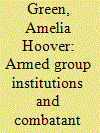

|
|
|
|
|
| Summary/Abstract |
Ex-combatants who fought with the Salvadoran Army during El Salvador’s 1980–92 civil war often recall being ‘captured’, rather than recruited, suffering beatings and humiliation in the course of training, and fighting without a sense of purpose or direction. Those who served with rebel forces, by contrast, recall fatigue and frustration with new routines, but seldom hazing or abuse; most also recalled deep, ongoing instruction about the purpose and goals of the war. This comparison highlights the broad variation in armed groups’ formal institutions for socialization, a topic that political scientists have only recently begun to examine in depth. The Salvadoran case also emphasizes some shortcomings of the existing literature, which may elide the differing effects of different formal institutions, treat individual institutions as operating independently on combatant behavior, and/or fail to map complex causal processes intervening between institutions and behavior. This article takes as its starting point the observation that many armed group institutions – including recruitment, military training, political training, and disciplinary regimes – are components of the process known more generally as ‘combatant socialization’. Examining specific institutional processes associated with combatant socialization allows for the generation of more refined and specific theories of combatant socialization as both a causal variable and an outcome. At the same time, treating armed group institutions as related elements of a broader process, rather than as fully separate institutions, may also advance understandings of the effects of these institutions. I demonstrate that the implementation and content of formal institutions for socialization varied significantly both across and within groups in El Salvador; building on this analysis, I lay out several potential directions for comparative research.
|
|
|
|
|
|
|
|
|
|
|
|
|
|
|
|
| 6 |
ID:
146153
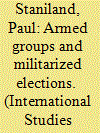

|
|
|
|
|
| Summary/Abstract |
Nonstate armed groups are often involved in electoral violence, but we know little about the origins or fates of these groups. This article develops an interactive theory of relations between governments and electoral armed groups. Governments assign different political roles to armed groups that reflect their ideological position and electoral value. State strategies flow from these political roles, but groups’ organizational capacity can allow them to resist government efforts to control, destroy, or incorporate them. The interaction of regime political interests and armed group autonomy leads to five distinct government-armed group trajectories, ranging from incorporation to violent conflict. I use comparative evidence from militarized elections in Karachi to illustrate the validity of the concepts and assess the power of the theory, while also exploring its limits and the need for future research. My argument and findings matter for our understanding of the linkages between democracy, civil conflict, and state power.
|
|
|
|
|
|
|
|
|
|
|
|
|
|
|
|
| 7 |
ID:
157231


|
|
|
|
|
| Summary/Abstract |
In this special issue we broaden the academic debate on rebel governance by examining additional armed actors – militias, police and foreign intervenors, and the ‘layers’ of governance they add. We develop the notion of ‘multi-layered’ governance to capture the complexity of these cases. We consider ‘mediated stateness’ as a special case of multi-layered governance. We discuss ‘polycentricity’ as an equivalent concept, but deem multi-layered governance more appropriate. The following articles discuss rebels’ legitimation strategies, armed opposition factions, auxiliary armed forces, mediated stateness and intervention by foreign powers to highlight the roles of different actors and the resulting impacts on governance.
|
|
|
|
|
|
|
|
|
|
|
|
|
|
|
|
| 8 |
ID:
143538
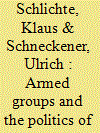

|
|
|
|
|
| Summary/Abstract |
This article serves as an introduction to a special section on the question of the legitimacy of non-state armed groups. Starting with a short discussion of the literature on armed groups as political actors, the authors emphasize the importance of the often-underestimated dimension of legitimacy. After having conceptualized legitimacy in more detail, the article addresses three key challenges armed groups usually face regarding the politics of legitimacy: first, they need to legitimize the use of violent means; second, for moral and material support, they depend on beliefs of legitimacy; and third, they need to simultaneously address various domestic and international audiences. Finally, the authors highlight a number of pending questions for further research on armed groups.
|
|
|
|
|
|
|
|
|
|
|
|
|
|
|
|
| 9 |
ID:
087995
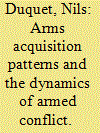

|
|
|
|
|
| Publication |
2009.
|
| Summary/Abstract |
Arms acquisition is a crucial venture for armed insurgency groups for carrying out their militant activities. I argue that the specific manner in which these groups obtain weapons may have important consequences for the dynamics of violent intrastate conflict. While most previous studies of the relationship between arms acquisition and armed conflict have focused solely on the impact of arms availability, in this article I analyze the impact of two specific aspects of arms acquisition patterns-the methods and the degree of leadership control-on the dynamics and nature of armed conflict in a qualitative case study of the armed conflict in the Niger Delta (Nigeria) between 1995 and 2005. I conclude that the specific arms acquisition method and the degree of leadership control over this process have strongly affected the dynamics of the conflict.
|
|
|
|
|
|
|
|
|
|
|
|
|
|
|
|
| 10 |
ID:
097132
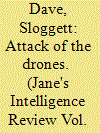

|
|
|
| 11 |
ID:
104796
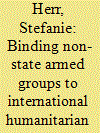

|
|
|
|
|
| Publication |
Frankfurt, Peace Research Insititute Frankfurt (PRIF), 2010.
|
| Description |
38p.
|
| Series |
PRIF report no.95
|
| Standard Number |
9783942532051
|
|
|
|
|
|
|
|
|
|
|
|
Copies: C:1/I:0,R:0,Q:0
Circulation
| Accession# | Call# | Current Location | Status | Policy | Location |
| 056057 | 341.481/HER 056057 | Main | On Shelf | General | |
|
|
|
|
| 12 |
ID:
161538
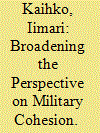

|
|
|
|
|
| Summary/Abstract |
It is difficult to underestimate the importance of cohesion for armed groups or organizations specialized and engaged in organized violence. This article argues that the recent debate on military cohesion has been far too narrow as it focused on Western state militaries during the 20th and 21st centuries, and even then only on the microlevel. It is necessary to broaden the perspective in order to construct theories that encompass even the vast majority of armed groups—the non-Western, nonstate, and nonmodern. This article advocates two ways of doing so: the investigation of cases that belong to these three types and broadening analysis to two new levels of analysis—the meso-level of armed groups and the macro-level, which contains state and society. Cohesion is established through harmonizing these three levels, which necessitates including them in the analysis in the first place.
|
|
|
|
|
|
|
|
|
|
|
|
|
|
|
|
| 13 |
ID:
171985
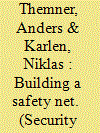

|
|
|
|
|
| Summary/Abstract |
The disarmament, demobilization, and reintegration of ex-combatants has become an integral part of peacebuilding. Although the main purpose of such interventions is to dissolve the military structures of armed groups, there is growing evidence that ex-combatant networks often remain intact. We investigate why such structures continue to thrive. We argue that ex-military networks are stronger when ex-commanders have weak links to elite patronage systems. Ex-combatants who are unable to rely on their former superiors for economic assistance must instead build denser ties to each other to gain access to a social safety net. To assess our argument, we conduct a comparative social network analysis (SNA) of two ex-military networks in Liberia. This innovative approach helps us uncover previously overlooked, but central, dynamics related to ex-combatant groups. We thereby show that SNA provides a range of underutilized tools and exact definitions that can increase our understanding of ex-military networks.
|
|
|
|
|
|
|
|
|
|
|
|
|
|
|
|
| 14 |
ID:
122240
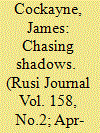

|
|
|
|
|
| Publication |
2013.
|
| Summary/Abstract |
Experience of conflict over the last two decades - from Haiti to Liberia to Afghanistan - points towards the likelihood that armed groups will adopt criminal strategies as a way of maintaining power during and after conflict, exploiting the state's vulnerability. However, policy responses have yet to prove effective in dealing with this threat. James Cockayne explores the relationship between criminal groups and political power, debunking longheld myths that such groups are primarily economic actors, before considering how a more strategic, evidence-based approach to tackling organised crime in conflict-affected states might be developed and implemented.
|
|
|
|
|
|
|
|
|
|
|
|
|
|
|
|
| 15 |
ID:
132395
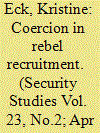

|
|
|
|
|
| Publication |
2014.
|
| Summary/Abstract |
Previous research on rebel recruitment has focused on the economic and social incentives groups used as enticements but has overlooked the question of why many armed groups recruit using coercion. The puzzle is why coercion occurs despite its alienating civilian populations and being costly in terms of organizational and military effectiveness. I suggest that recruitment is a dynamic process and that groups are likely to shift recruitment strategies depending on the exigencies of the conflict. In particular, the exposure of the group to military and economic shocks accompanied by shortened time horizons should lead to increasingly coercive recruitment. Whether forced recruitment is a durable solution for a group in the long run is likely to be contingent upon the group's ability to induce a high level of compliance from the individual at a low cost. Further, in order to circumvent costs vis-à-vis the civilian population, the group must be able to restrict defection to the government and the out-migration of the civilian population. Three narratives from Nepal, Ethiopia, and Sierra Leone are provided both to illustrate the arguments and to probe the scope conditions. The article concludes that understanding why and when rebel groups use forced recruitment has vital security implications for the countries in which armed conflict takes place.
|
|
|
|
|
|
|
|
|
|
|
|
|
|
|
|
| 16 |
ID:
184199
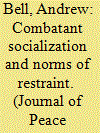

|
|
|
|
|
| Summary/Abstract |
Can armed groups socialize combatants to norms of restraint – in essence, train soldiers to adopt norms of international humanitarian law on the battlefield? How can social scientists accurately measure such socialization? Despite being the central focus of organizational and ideational theories of conflict, studies to date have not engaged in systematic, survey-based examination of this central socialization mechanism theorized to influence military conduct.
This study advances scholarly understanding by providing the first comparative, survey-based examination of combatant socialization to norms of restraint, using surveys and interviews with US Army cadets at the US Military Academy (USMA), Army Reserve Officer Training Corps (ROTC), and active duty Army combatants. Additionally, to better understand ‘restraint’ from combatants’ perspective, this study introduces the concept of the ‘combatant’s trilemma’ under which combatants conceptualize civilian protection as part of a costly trade-off with the values of military advantage and force protection.
Survey results hold both positive and negative implications for socialization to law of war norms: military socialization can shift combatants’ preferences for battlefield conduct. However, intensive norm socialization may be required to shift combatants’ preferences from force protection to civilian protection norms. Study findings hold significant implications for understanding violence against civilians in conflict and for policies to disseminate civilian protection norms in armed groups worldwide.
|
|
|
|
|
|
|
|
|
|
|
|
|
|
|
|
| 17 |
ID:
147832
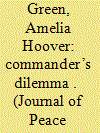

|
|
|
|
|
| Summary/Abstract |
This article proposes a framework for understanding variation in armed groups’ abilities to control wartime violence, including violence against civilians. I argue that patterns (both levels and forms) of violence are shaped by armed group leaders’ attempts to meet two conflicting imperatives. To succeed, commanders must build a fighting force capable of swift, unhesitating violence; they must also maintain some control over the level, form(s), and targeting of violence. I refer to this situation as the Commander’s Dilemma. Drawing on literatures from psychology and sociology, I argue that effective behavioral control cannot be achieved via extrinsic incentives (i.e. pecuniary or non-pecuniary rewards and punishments) alone. Rather, effective control of combatant violence depends upon armed group institutions intended to align combatants’ preferences with those of commanders. I therefore focus analytically on political education, the armed group institution most likely to operate in this way. In particular, I hypothesize that armed groups with strong and consistent institutions for political education should display, on average, narrower repertoires of violence than those without. This argument finds preliminary support in a cross-national analysis of reported rape by rebel forces, as well as a qualitative investigation of armed groups during civil war in El Salvador. More broadly, this approach suggests that the creation of restraint is at least as important to our understandings of wartime violence as the production of violence.
|
|
|
|
|
|
|
|
|
|
|
|
|
|
|
|
| 18 |
ID:
076497
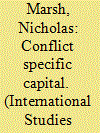

|
|
|
|
|
| Publication |
2007.
|
| Summary/Abstract |
This article presents a correspondence between the mode of weapons acquisition by armed opposition groups and the form of a civil war. The mode of arms acquisition is affected by two factors-availability and control over the acquisition process. Variations in the mode of arms acquisition correspond to three types of insurgency: led by a single and organized group, warlordism, and disorganized armed bands. This article discusses how weapons acquisition is considered in the existing literature on arms and civil conflict, and examines the definitions of arms availability. It provides new insights on the availability and control of weapons in civil conflict and provides examples from Nepal, Iraq, and Afghanistan. The article concludes with an examination of the policy implications of its findings.
|
|
|
|
|
|
|
|
|
|
|
|
|
|
|
|
| 19 |
ID:
139095
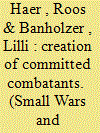

|
|
|
|
|
| Summary/Abstract |
Theories on conflict behaviour regard armed groups as unitary actors whose members faithfully execute the orders of their leaders. Nevertheless, in reality mutinies, insubordination and fractionalisation occur. We argue that the faithful execution of orders depends on the level of organisational commitment of combatants. This level can be increased with the help of four management strategies. Using a dataset based on fieldwork in the Democratic Republic of the Congo, we analyse the influence of each of these strategies. The Bayesian analyses show that recruitment, training and promotion has statistical reliable influence, but that providing rewards does not.
|
|
|
|
|
|
|
|
|
|
|
|
|
|
|
|
| 20 |
ID:
089089
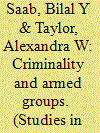

|
|
|
|
|
| Summary/Abstract |
Terrorist groups and armed insurgents regularly exploit illicit markets to launder money, traffic illegal goods, and purchase arms. In such an environment, the line between armed political organizations and criminal groups appears to break down. However, through a comparative study of paramilitary groups and Fuerzas Armadas Revolucionarias de Colombia (Revolutionary Armed Forces of Colombia-FARC) in Colombia, this article finds that group goals, the political environment, and membership strongly influence the types of criminal activities a given armed groups undertakes. Thus, the membership and political agenda of sub-state armed groups not only distinguishes them from criminal groups-organized for and motivated by economic gain-but also shapes their criminal behavior.
|
|
|
|
|
|
|
|
|
|
|
|
|
|
|
|
|
|
|
|
|